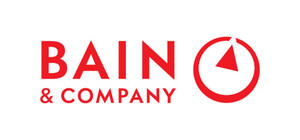NEW YORK, May 16, 2019 /PRNewswire/ -- The current economic expansion, which now exceeds 10 years – long by historical standards – as well as signs of over-leverage in the corporate sector and geopolitical uncertainty, including the China-U.S. trade war, Brexit, and economic instability in some European countries, suggests that the next recession likely will arrive soon. According to new research from Bain & Company, Beyond the Downturn: Recession Strategies to Take the Lead, well-prepared companies emerged as winners during and after past recessions. These companies managed a strong defense and offense in parallel, reining in costs while simultaneously reinvesting in growth. In short, preparing now gives companies more options.
Bain & Company's analysis of nearly 3,900 companies worldwide found that winners diverged from losers during the past recession and widened the profit and market cap gap during the subsequent expansion. Winners grew at a 17 percent compound annual growth rate (CAGR) during the downturn, compared to 0 percent among the losers. Even after the downturn, the winners grew at an average 13 percent CAGR while the losers stalled at 1 percent. For two U.S. companies with a similar enterprise value in 2007, the winners' average enterprise value grew three times that of the losers by 2017. That difference is worth $6 billion in additional enterprise value.
The eventual winners deliberately planned to capture opportunities before the recession in ways that are just as relevant today. While they focused intensively on cost containment, they also looked beyond cost. Playing offense almost always trumps simply hunkering down, and the best companies usually gain market share during a challenging economy.
"Think of a recession as a sharp curve on race track – it's the best place to pass competitors, but requiring more skill than on straightaway," said Tom Holland, co-author of the research and a partner with Bain & Company's Accelerated Transformation business. "The best drivers brake hard just ahead of the curve, turn hard toward the apex of the curve and accelerate hard out of the curve. Winning companies take out excess costs, identify the short list of projects that will form their next business model, and spend and hire before markets rebound."
On the other hand, the losing companies, based on Bain & Company's analysis tended to follow a few dead ends. Some tried to slash and burn their way to the other side, under the misconception that extreme cost-cutting would stabilize the enterprise. Other lagging companies strayed outside their core business, investing in the latest hot sectors and tools, praying for a winner. Still others tolerated poor results during the downturn, waiting to see what would happen, and then finally took action – too late because they bought the wrong asset or paid an inflated price.
What specifically distinguishes eventual winners? Bain & Company's research has teased out several moves by companies that outperformed peers, involving four areas:
1. |
Restructure costs before the downturn hits, without cutting muscle at the core. When companies saw greater urgency around cost, some were able to manage their cost structure by reducing the amount of work and simplifying processes. They viewed cost management as a way to refuel the engine for the next stage in the business cycle. |
2. |
Put the financial house in order. Recessions can wreak havoc on finances, so it's essential to track precisely where capital currently is deployed and to review the liquidity position in order to mitigate the risk of being caught short of cash. Once those positions become clear, companies may want to zero-base the capital budget, so that the capex strategy ties directly to the corporate strategy throughout and following after the recession. |
3. |
Play offense by reinvesting selectively for commercial growth. The strongest companies coming out of recessions went on offense early while others thought only about survival. Among the tactics used to boost commercial growth are the following: |
|
|
4. |
Pursue a proactive M&A pipeline. For incumbent companies, downturns present a window to use M&A to buy new product lines, customer segments or capabilities at lower prices. Planning those investments now allows companies to avoid paying a higher cost of capital later when interest rates rise. |
"Based on their starting point in terms of strategic and financial strength, winning companies take a future-back approach – that is, they visualize a future state and work backwards to identify milestones along the way – to seize the unique opportunities that a downturn presents," said Jeff Katzin, a partner in Bain & Company's Customer Strategy & Marketing Practice and co-author of the report. "Once management has established its position, trying to react hastily in a crisis will not work. To raise the odds of success, it is more effective to map out a series of offensive moves for the next few years that aim to propel a stronger enterprise through and out of the downturn."
Editor's Note: To arrange an interview, contact Dan Pinkney at [email protected] or +1 646 562 8102
About Bain & Company
Bain & Company is the management consulting firm that the world's business leaders come to when they want results. Bain advises clients on private equity, mergers and acquisitions, operations excellence, consumer products and retail, marketing, digital transformation and strategy, technology, and advanced analytics, developing practical insights that clients act on and transferring skills that make change stick. The firm aligns its incentives with clients by linking its fees to their results. Bain clients have outperformed the stock market 4 to 1. Founded in 1973, Bain has 57 offices in 36 countries, and its deep expertise and client roster cross every industry and economic sector. For more information visit: www.bain.com. Follow us on Twitter @BainAlerts.
Media Contact:
Dan Pinkney
Bain & Company
Tel: +1 646 562 8102
[email protected]
SOURCE Bain & Company

Related Links
WANT YOUR COMPANY'S NEWS FEATURED ON PRNEWSWIRE.COM?
Newsrooms &
Influencers
Digital Media
Outlets
Journalists
Opted In




Share this article